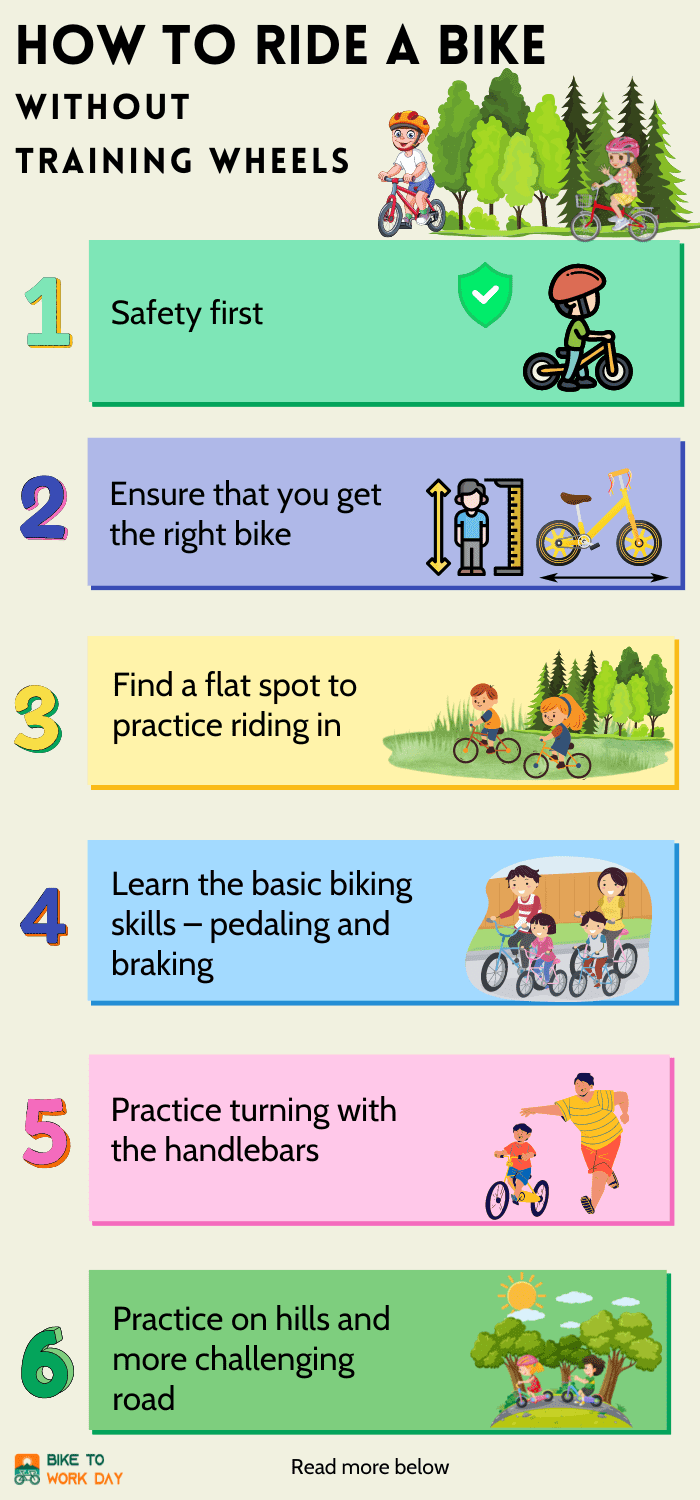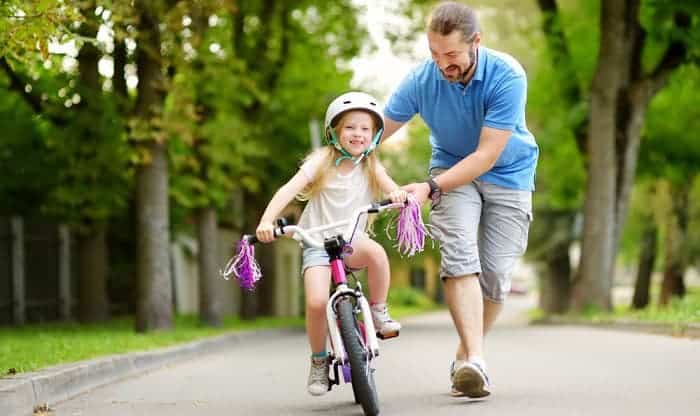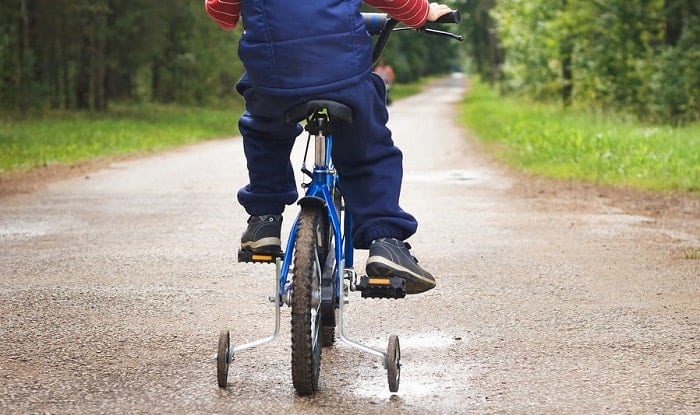Learning a new skill is no easy feat. It requires time and patience to perfect the skills. Knowing how to bike is one of the most rewarding experiences you could have. It is a road to exciting and new adventures later in life.
Both adult and child learners go through the critical process of learning how to ride a bike without training wheels. It is the most ideal way to develop the balance needed to ride a bike. It gives you a sense of freedom and control once you ride a bike without training wheels.
Riding a bike without training wheels is easy if you follow the most essential steps, including putting safety first, practicing on flat surfaces, learning to pedal and brake, and so much more.
If you want the full details, read our guide about riding a bike without training wheels here.
Table of Contents
What are Bike Training Wheels
Training wheels or stabilizers are extra wheels attached to the back wheel of your bike. They are added features of a bicycle to assist learners in pedaling and developing balance on a bike. Traditionally, training wheels are installed to teach young learners to be comfortable with riding on a bike.
A bike with training wheels enables you to practice without worrying about your balance or getting harmed. You can develop your coordination, agility, and sense of balance with the assistance of training wheels.
However, you cannot continue riding on a bike with training wheels forever. Once you are developed and confident enough, you will have the right balance and coordination when cycling to graduate from using training wheels.
You can follow this helpful guide about learning to ride a bike without training wheels:
- Put safety first
- Get the right bike
- Practice on flat surfaces
- Learn to pedal and brake
- Practice on hills
How to Ride a Bike without Training Wheels
Safety first
Even with training wheels installed, safety should always be your utmost consideration. There are various safety gears you can use to keep you well-protected when practicing riding on a bike. You can use a bike helmet to prevent damage when you fall with your head and hurt your upper body.
When kid bikes without training wheels, there are other gears you can add, including elbow pads, knee pads, and wrist guards. These gears will not only prevent you from getting hurt but will also give you confidence in cycling without training wheels.
Ensure that you get the right bike
Cycling without the training wheels is easier if you use the right bike for you. It means that your bike should be compatible with your height and the length of your legs. It is vital that when you are seated on the bike, your feet can still touch the ground.
Riding will be less scary if you are aware that you can still control your navigation. When your feet can touch the ground, you are able to control the movement of your bike. If you lose balance, you can easily put your feet on the ground and stop the ride.
Find a flat spot to practice riding in
As a beginner who still feels scared riding a bike without training wheels, you can initially practice on a flat surface and build confidence from there. You can bring your bike to an area with flat and extended space so you can navigate effectively.
You can practice biking on a parking lot or grassy land, so it won’t hurt too much when you fall down. It is important to build your balance and confidence on a flat surface before riding on a bumpy and hilly road.
Learn the basic biking skills – pedaling and braking
More than balance and coordination, pedaling and braking are crucial skills to develop when you teach bike riding without training wheels. It will help you navigate your bike more effectively and increase the level of your confidence in cycling.
To do this, you can sit on your bike and hold yourself up by ensuring that your feet are touching the ground. Then, once you establish balance, you can put one foot on the pedal and push it down. After which, you can push yourself forward by putting another foot on the other side of the pedal.
Once both of your feet are sitting comfortably on the pedal, you can continue pedaling by pushing your feet on the pedal alternately. Do this repeatedly and master the skill of pedaling. If you want to stop, you can stop both of your feet, put them on the ground, and use your bike brake to keep your bicycle from moving.
Practice turning with the handlebars
Of course, you cannot fully experience the fun of biking if you keep going in a straight direction. It is essential to practice turning with the help of handlebars. In this way, you can bike in different directions while moving from right to left, and vice versa.
Once you have mastered pedaling and braking, the next step is learning how to turn left and right. You can start slow; once you build up your skill, you can gradually increase your pacing.
Practice on hills and more challenging road
Once you have developed the most important technical skills like pedaling, braking, and turning, it is time to challenge yourself. You can level up your biking skills if you increase the difficulty in cycling.
It means you have to look for more challenging roads like hills. You can go up and down hills to advance yourself in both pedaling and turning. You should find a small hill or slope, and pedal your way up there.
The more challenging the road is, the more effort you should put into pedaling. When you are going up the hill, you should put more energy into pedaling. If you are going down the hill, you should control your brake to keep your movement slower.
Once you have already navigated this difficult road, you can repeatedly practice until you are certain that you have mastered biking. You will know that you can bike without training wheels if you are not feeling scared anymore when biking.
Additional Tips
Biking is a rewarding skill, but before you get the most out of it, you will face challenges and difficulties along the road. In order not to feel discouraged, it is crucial that you also remember the following:
Develop patience
In everything that you do, patience is the key to become successful. It is a mandatory attribute to keep you encouraged in learning to bike. Always be interested in biking and never give up if you feel like you want to stop.
Ask for help or get a biking body.
Learning a new skill is more fun if you share it with someone who has the same interest as you. In this way, you can help each other and learn together. The best way to learn how to bike is when someone supports you every step of the way.
Always keep your focus on the goal.
If you have a goal in mind – learn to cycle without training wheels, learning is easier. You can put all your energy into mastering the skill and put your focus and attention on it. You can learn fast when you are focused and well-directed.
Reward yourself
Biking is a life skill that can help you in the long run. At first, it will be difficult to learn where you can get hurt, but it is very fulfilling. It is important to have positive reinforcement or reward yourself after completing your training on how to bike.
Conclusion
Finally, you are now ready to go on adventures riding on a bike without training wheels! The things we shared above can potentially help you build confidence and develop your balance when cycling without using training wheels.
We hope that you find this article on how to ride a bike without training wheels useful and increase your level of confidence when on the road. If you have any more questions and thoughts, you can leave your questions down below so we can help you out.

“Bike commuting should be the trend for the next few years, and it is a convenient and eco-friendly way for us to travel. And we are here to make it a bit less troublesome for people who want to maintain their vehicle for a long time. So, the content I expect to put out here is offering help for bikers who are facing issues with parts of their bikes once in a while. Let’s have fun and protect the environment together!”




